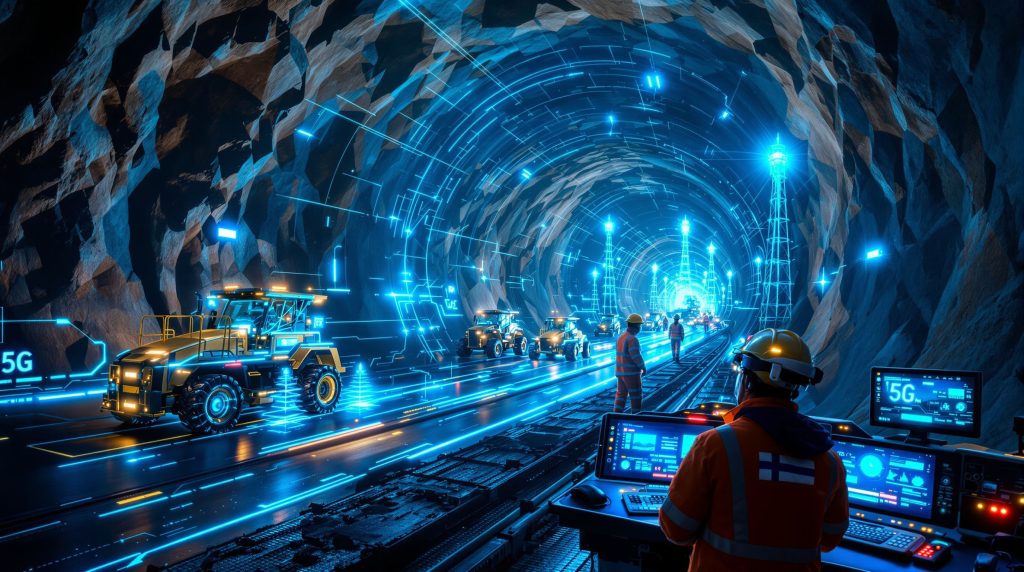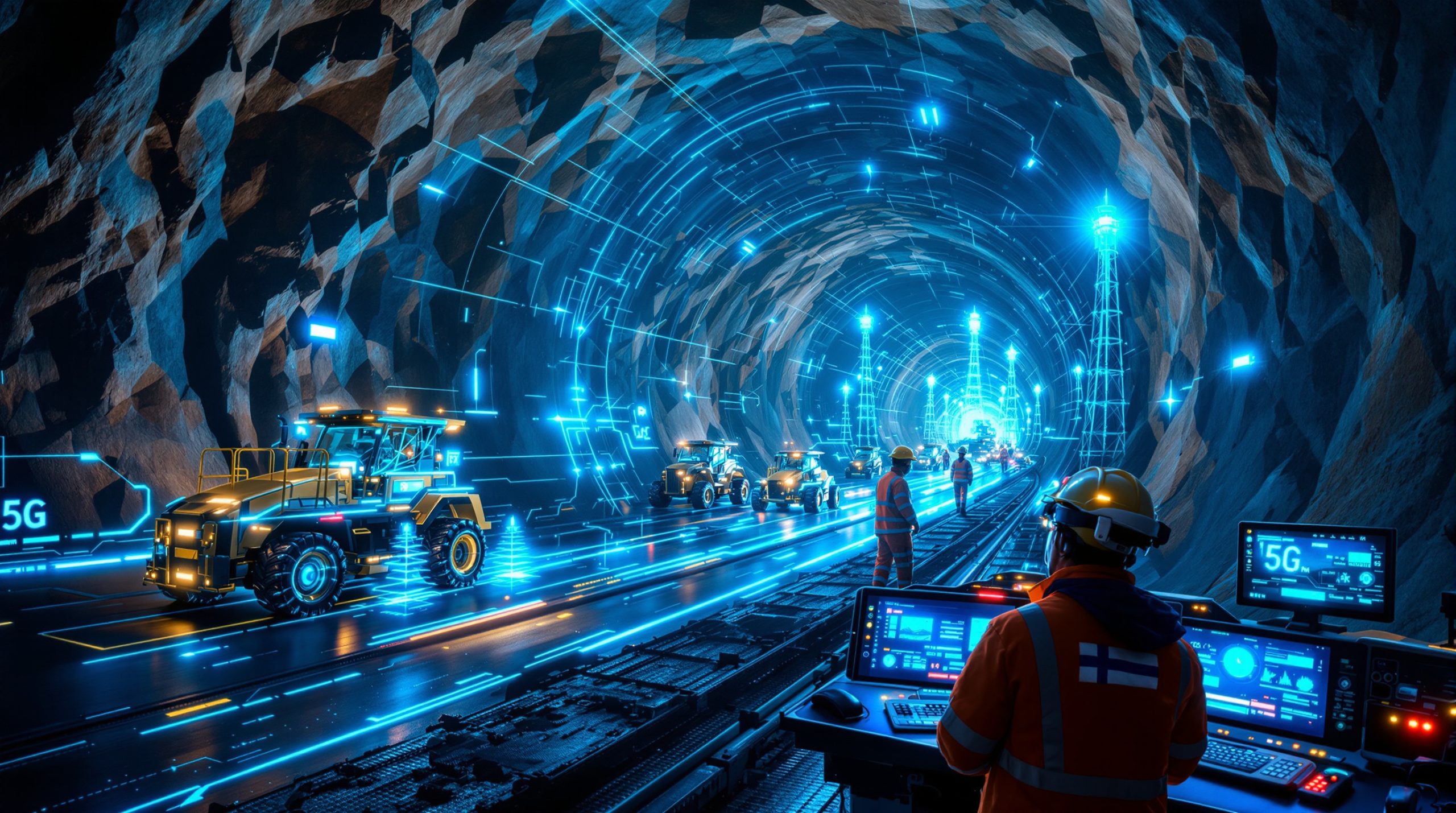Revolutionizing Underground Mining: How 5G Networks Transform Operations at 1.5km Depths
Underground mining has long faced significant challenges in maintaining reliable communications. Traditional technologies struggle with signal degradation, interference from rock formations, and navigating complex tunnel systems, especially at extreme depths. The recent breakthrough deployment of private 5G networks is changing this landscape dramatically, offering unprecedented connectivity solutions for one of the world's most demanding environments.
What is a Private 5G Underground Network and Why Does Mining Need It?
The Connectivity Challenge in Underground Mining
Underground mining operations face unique connectivity obstacles that surface-level industries don't encounter. At depths reaching 1.5 kilometers, conventional wireless technologies simply cannot maintain reliable performance. Dense rock formations block signals, tunnel geometries create unpredictable signal paths, and harsh environmental conditions damage standard equipment.
These connectivity limitations have historically constrained mining operations in multiple ways. Safety protocols rely on consistent communication, operational efficiency suffers without real-time data exchange, and modern automation technologies remain underutilized without the necessary network infrastructure to support them.
The Boldyn-Nokia Solution: Private 5G Underground
The partnership between Boldyn Networks and Nokia has created a groundbreaking solution at the Callio Pyhäjärvi FutureMine in Finland. This former copper mine now serves as a sophisticated testing ground for next-generation mining technologies, with operations extending to remarkable depths of 1.5 kilometers below the surface.
The private 5G network leverages Nokia's Modular Private Wireless (MPW) technology specifically engineered for underground environments. This deployment differs significantly from standard commercial networks in several key ways:
- It provides dedicated bandwidth exclusively for mining operations, ensuring critical applications always receive the necessary network resources
- Enhanced security protocols protect sensitive operational data from unauthorized access
- Customized coverage mapping addresses the unique challenges of complex tunnel systems
- Hardened infrastructure withstands the harsh conditions of underground mining environments
How Does 5G Technology Function 1.5km Below the Surface?
Technical Infrastructure Components
Deploying functional 5G networks at extreme depths requires specialized infrastructure configurations not found in typical surface installations:
- Base stations positioned strategically throughout tunnel networks to maintain signal coverage
- Ruggedized antenna systems designed to withstand moisture, dust, vibration, and temperature fluctuations
- Redundant power systems with battery backups to ensure continuous operation even during power disruptions
- Signal repeaters installed at key junctions to maintain connectivity around corners and through obstacles
- Edge computing nodes that process time-sensitive data locally to reduce latency for critical applications
Overcoming Underground Signal Propagation Challenges
The Boldyn-Nokia implementation addresses several unique challenges specific to deep mining environments through innovative technical solutions:
| Challenge | Technical Solution | Operational Benefit |
|---|---|---|
| Signal absorption by rock formations | Higher power transmission combined with strategic repeater placement | Consistent coverage throughout tunnel networks |
| Complex tunnel geometry creating dead zones | Custom RF planning with directional antennas | Elimination of communication shadows |
| Environmental interference from machinery | Frequency isolation and advanced noise cancellation | Clear voice and data transmission even in active mining areas |
| Limited power availability | Energy-efficient equipment with integrated backup systems | Uninterrupted service during power fluctuations |
What Mining Operations Can 5G Enable at Extreme Depths?
Real-Time Monitoring and Remote Operations
The high-bandwidth, low-latency characteristics of 5G networks enable capabilities previously impossible in underground environments:
-
Personnel Tracking and Safety Systems: Wearable devices connected to the network provide real-time location data for all workers, enabling immediate response during emergencies and ensuring no personnel are unaccounted for during evacuations.
-
Environmental Monitoring: Distributed sensor networks throughout the mine continuously measure air quality, gas levels, temperature, and potential hazards, with data instantly transmitted to control centers for analysis and response.
-
Remote Equipment Operation: Surface-based operators can control underground machinery with minimal latency, removing personnel from potentially dangerous environments while maintaining precise control over equipment.
Advanced Data Collection and Analysis
The robust connectivity supports comprehensive data gathering across all aspects of mining operations:
- High-definition video streams from multiple locations enable real-time inspection of mining faces, equipment, and infrastructure
- Structural monitoring sensors continuously assess tunnel integrity and provide early warning of potential stability issues
- Predictive maintenance systems collect performance data from equipment to identify potential failures before they occur
- Connected drilling equipment transmits geological mapping data and ore quality assessments to surface operations centers
How Are Companies Testing and Implementing 5G Mining Technologies?
The Callio Test Mine as an Innovation Hub
The former Pyhäsalmi copper mine has been transformed into a world-class testing facility where mining technology companies can validate next-generation solutions in a real underground environment:
-
Normet's Equipment Testing: This leading mining equipment manufacturer is utilizing the 5G infrastructure to test advanced underground vehicles and machinery with enhanced connectivity requirements. Their testing focuses on remote operation capabilities and automated equipment performance in challenging environments.
-
Cybercube's Digital Solutions: This technology provider is leveraging the high-bandwidth network to develop and test sophisticated mining software applications that process and visualize complex operational data. Their solutions focus on creating digital twins of mining operations for improved planning and execution.
-
Autonomous Vehicle Trials: Multiple vendors are testing self-driving underground vehicles that rely on constant communication with control systems. These vehicles must navigate complex environments while maintaining precise positioning and safety parameters.
Real-World Implementation Challenges and Solutions
Deploying advanced connectivity solutions at extreme depths presents unique challenges that require innovative approaches:
-
Installation Logistics: The physical installation of network equipment in confined underground spaces requires specialized mounting hardware and techniques developed specifically for mining environments.
-
Power Management: Providing reliable electricity to network components throughout extensive tunnel systems demands innovative power distribution solutions and efficiency-focused equipment design.
-
Maintenance Accessibility: Network infrastructure must be designed with serviceability in mind, allowing for efficient maintenance despite difficult access in underground environments.
-
Environmental Resilience: Electronic components require robust protection from moisture, dust, and temperature fluctuations, necessitating specialized enclosures and cooling systems.
What Benefits Does 5G Bring to Underground Mining Safety?
Enhanced Emergency Response Capabilities
The robust communication infrastructure dramatically improves safety protocols and emergency response:
-
Instant Alert Systems: Emergency notifications reach all personnel simultaneously regardless of location, ensuring everyone receives critical information immediately.
-
Two-Way Communication: Clear voice channels remain available even during incidents, allowing trapped or injured workers to communicate with rescue teams.
-
Evacuation Guidance: Connected devices can provide real-time directions to the nearest exits, adapting routes based on developing situations.
-
Medical Telemetry: Vital signs of injured workers can be monitored remotely while evacuation is underway, allowing medical teams to prepare appropriate responses.
Preventative Safety Measures
Beyond emergency response, the network enables sophisticated proactive safety systems:
-
Continuous structural monitoring with distributed sensor networks can detect potential tunnel instability before collapses occur
-
Automated equipment shutdown protocols activate when unauthorized personnel are detected in restricted zones
-
Real-time air quality monitoring systems trigger immediate ventilation adjustments when hazardous conditions develop
-
Advanced analytics platforms identify potential safety risks by analyzing patterns across operational data
How Does 5G Underground Connectivity Drive Mining Efficiency?
Operational Optimization Through Data Integration
The comprehensive connectivity enables sophisticated optimization across all mining processes:
-
Integrated Production Planning: Real-time data from extraction, transport, and processing areas allows for dynamic scheduling and resource allocation, minimizing bottlenecks and maximizing throughput.
-
Equipment Utilization Tracking: Continuous monitoring of machinery usage patterns identifies efficiency opportunities and ensures optimal deployment of assets throughout the operation.
-
Energy Management: Smart systems adjust power consumption based on actual operational needs, reducing energy costs while ensuring critical systems remain functional.
-
Inventory and Supply Chain Integration: Automated tracking of materials from extraction to processing creates visibility throughout the production cycle, improving planning and reducing delays.
Productivity Metrics and Improvements
Early implementations of underground 5G networks have demonstrated measurable benefits to operational efficiency:
- Significant reduction in equipment downtime through predictive maintenance and real-time monitoring
- Decreased cycle times for loading and hauling operations through optimized routing and coordination
- Improved ventilation efficiency through targeted air distribution based on real-time occupancy and air quality data
- Enhanced blasting outcomes through precise detonation timing and comprehensive post-blast analysis
What Future Applications Will Underground 5G Enable?
Next-Generation Mining Technologies
The robust connectivity infrastructure establishes the foundation for revolutionary mining approaches:
-
Fully Autonomous Mining: Complete removal of humans from hazardous underground environments through remotely operated or fully autonomous equipment fleets working in coordinated systems.
-
Digital Twin Integration: Creating comprehensive virtual replicas of entire mining operations for simulation, planning, and optimization before implementing changes in the physical environment.
-
AI-Powered Decision Support: Advanced algorithms analyzing operational data in real-time to recommend optimal extraction strategies, equipment deployment, and maintenance scheduling.
-
Mixed Reality Applications: Augmented and virtual reality tools for training, maintenance guidance, and operational visualization that overlay digital information onto the physical environment.
Integration with Surface Operations
The underground network will increasingly connect seamlessly with above-ground systems:
- End-to-end visibility of materials from extraction to processing, enabling optimized planning across the entire operation
- Coordinated logistics between underground and surface transportation systems to minimize transfer delays
- Unified data-driven mining operations platforms integrating all aspects of mining operations for comprehensive analysis and decision-making
- Remote expert collaboration regardless of physical location, bringing specialized knowledge to problem-solving
How Can Mining Companies Prepare for 5G Implementation?
Infrastructure Assessment and Planning
Organizations considering 5G deployment should follow a structured approach to implementation:
-
Connectivity Audit: Evaluate current communication systems and identify critical gaps that limit operational effectiveness or safety protocols.
-
Use Case Prioritization: Determine which applications will deliver the most significant operational benefits and focus initial implementation efforts on these high-value areas.
-
Phased Implementation Planning: Develop a staged approach to network deployment aligned with operational priorities and budget constraints.
-
Skills Development: Prepare the workforce for new technologies and operational models through comprehensive training programs and change management initiatives.
Investment Considerations and ROI Analysis
The business case for underground 5G requires careful financial evaluation:
-
Capital Expenditure Planning: Understanding the upfront costs of network infrastructure, including hardware, installation, and integration with existing systems.
-
Operational Cost Impact: Calculating the ongoing expenses of maintaining advanced connectivity, including power consumption, maintenance, and technical support.
-
Productivity Benefit Quantification: Measuring the expected improvements in efficiency, throughput, and equipment utilization to determine operational value.
-
Safety and Risk Reduction Value: Assessing the financial impact of enhanced safety measures, including reduced incidents, improved emergency response, and lower insurance premiums.
Frequently Asked Questions About Underground 5G Mining Networks
What makes mining environments particularly challenging for wireless communications?
Underground mining presents multiple unique challenges for wireless networks. Signal-blocking rock formations create natural barriers that traditional signals struggle to penetrate. Complex tunnel geometries create unpredictable multipath interference patterns that can degrade signal quality. High moisture levels affect signal propagation characteristics, while limited installation space constrains equipment deployment options. Additionally, the dynamic nature of mining operations means the physical environment constantly changes, requiring adaptive network configurations that can evolve with the mining process.
How does 5G differ from previous wireless technologies used in mining?
5G technology offers several critical advantages over earlier wireless systems used in mining environments. It provides significantly higher bandwidth capacity, supporting data-intensive applications like high-definition video streaming and real-time analytics that were previously impossible underground. The ultra-low latency (response time) enables remote control of equipment with minimal delay, making precise operation possible even from surface control centers. Network slicing capabilities allow operations to prioritize critical communications over less essential traffic, while massive connection density supports thousands of IoT sensors and devices operating simultaneously throughout the mine.
What security considerations exist for private mining networks?
Mining operations implementing private 5G networks must address several key security concerns. Physical protection of network infrastructure from harsh environmental conditions is essential for maintaining reliable operations. Comprehensive cybersecurity measures must prevent unauthorized access to operational technology systems that control critical equipment and infrastructure. Robust data protection protocols must safeguard sensitive production information that could have commercial implications. The network must also demonstrate resilience against both deliberate interference attempts and natural disruptions that could compromise operations or safety systems.
How can existing mines transition to 5G technology?
The transition to 5G typically involves a carefully planned, phased approach. Most operations begin with a comprehensive site survey to understand current connectivity challenges and identify optimal equipment placement locations. This is followed by pilot implementations in critical operational areas to validate performance and refine deployment strategies. Gradual expansion of coverage follows successful pilots, with continuous integration efforts connecting the new network with existing operational technology systems. Throughout this process, mines typically maintain legacy systems alongside new technology to ensure operational continuity during the transition period.
Conclusion: The Transformative Impact of Underground 5G Networks
The deployment of private 5G networks in underground mining environments represents a pivotal advancement in the industry's digital transformation journey. By overcoming the significant challenges of subterranean communications, these networks enable unprecedented levels of safety, efficiency, and AI-enhanced mining efficiency at depths previously considered prohibitive for advanced technology implementation.
As demonstrated by the Boldyn-Nokia partnership at the Callio FutureMine, the technology has matured to a point where reliable, high-performance connectivity can be achieved even at extreme depths of 1.5 kilometers. This breakthrough enables mining companies to reimagine operational models, implementing remote operations, autonomous equipment, and comprehensive digital monitoring systems previously impossible in underground engineering marvels.
The mining industry stands at the threshold of a new era where digital capabilities extend to the furthest reaches of underground operations, driving improvements across safety, productivity, and sustainability metrics while creating new possibilities for resource extraction in challenging environments. Furthermore, the integration of AI-driven drilling & blasting techniques with this robust connectivity infrastructure will accelerate the adoption of mining innovation trends that promise to revolutionize the industry.
Further Exploration:
Readers interested in learning more about underground mining technology advancements can explore related educational resources about private 5G implementations in industrial settings and follow developments from key technology providers in this space.
Looking for the Next Big Mining Stock Opportunity?
Discover promising investment opportunities in the mining sector before they reach mainstream attention by leveraging Discovery Alert's proprietary Discovery IQ model, which delivers real-time notifications of significant ASX mineral discoveries as they happen. Visit the discoveries page to explore historic examples of exceptional investment returns from major mineral discoveries.




